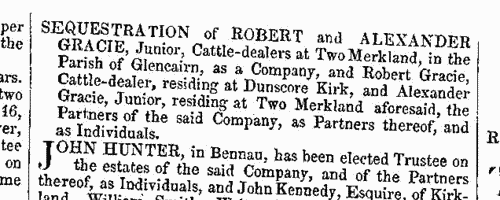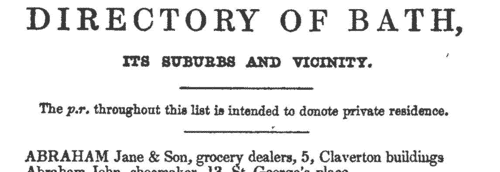Add this eBook to your basket to receive access to all 295 records. Our indexes include entries for the spelling penney. In the period you have requested, we have the following 295 records (displaying 81 to 90): These sample scans are from the original record. You will get scans of the full pages or articles where the surname you searched for has been found. Your web browser may prevent the sample windows from opening; in this case please change your browser settings to allow pop-up windows from this site. London aldermen, councillors, officers and officials
(1841)
The Royal Kalendar lists the mayor and aldermen of the city of London, annotated with ward, year of election, and address; deputies and common-council men of the city, by ward, with the names of their respective livery companies; the city officers; officials of the Irish Society; Commissioners of Sewers, Lamps and Pavements; the Royal Exchange and Gresham Trust Committee; Gresham College; City of London School; the Commissioners of the Lieutenancy for the London; magistrates and clerks of the London police offices; and officials of the Honourable Artillery Company; and commissioners and officials of the Office of the Metropolitan Roads north of the Thames. Then, gathered together until the title of Miscellaneous Institutions, are the Metropolitan Commissioners in Lunacy; the Scottish Corporation for the Relief of Natives of Scotland who have acquired no Parochial Settlement; Morden College for Decayed Merchants; the Alfred Society; the Travellers' Society; the Grand Lodge of Freemasons of England; Royal Freemasons School; Royal Masonic Institution; Society of Ancient Britons; Royal Humane Society; Mile End Philanthropic Society; Society for the Relief of Distressed Widows; City of London General Pension Society; Society for the Discharge and Relief of Persons Imprisoned for Small Debts; Friendly Female Society for Relieving Poor, Infirm and Aged Widows and Single Women, of Good Character, who have Seen Better Days; Society of Friends of Foreigners in Distress; London Female Penitentiary; Patriotic Fund; Corporation of the Refuge for the Destitute; Society for the Improvement of Prison Discipline and for the Reformation of Juvenile Offenders; Guardian Society for the Preservation of Public Morals; Society for the Suppression of Mendicity; Medical Benevolent Society; British and Foreign Anti-Slavery Society; and the General Cemetery Company. | Sample scan, click to enlarge

| Petitioning Creditors and Solicitors
(1841)
Principal creditors petitioning to force a bankruptcy (but often close relatives of the bankrupt helping to protect his assets): and solicitors | Sample scan, click to enlarge

|  London Policemen
(1830-1842) London Policemen
(1830-1842)
The Metropolitan Police Register of Joiners (MEPO 333/4) lists policemen joining the force through to 31 December 1842 (to warrant number 19892). The register is alphabetical, in so far as the recruits are listed chronologically grouped under first letter of surname. It is evidently a continuation of a similar earlier register, not closed until its alphabetical sections were filled: consequently, there are no entries in this register for the initial letters N, O, Q, U, V, X, Y or Z; and the sections of this register start at different dates - A 18 April 1840 (warrant number 16894); B 11 December 1830 (5570); C 7 September 1830 (4988); D 27 May 1833 (8445); E 15 December 1838 (14476); F 30 March 1832 (7372); G 1 December 1835 (11,184); H 25 April 1832 (7457); I and J 13 February 1837 (12449); K 2 January 1838 (13457); L 3 October 1834 (9905); M 15 November 1832 (7999); P 4 October 1831 (6869); R 4 September 1837 (13021); S 30 March 1835 (10366); T 6 April 1840 (16829); W 30 December 1833 (9096). The register gives Date of Appointment, Name, Number of Warrant, Cause of Removal from Force (resigned, dismissed, promoted or died), and Date of Removal. Although the register was closed for new entrants at the end of 1842, the details of removals were always recorded, some being twenty or more years later. Those recruits not formerly in the police, the army, or some government department, were required to provide (normally) at least two letters of recommendation from persons of standing, and details of these are entered on the facing pages: the names in these are indexed separately - this index refers only to the police constables. Where a recruit was only recently arrived in the metropolis, the names and addresses of the recommenders can be invaluable for tracing where he came from. | Sample scan, click to enlarge

|  Persons of standing recommending London police recruits
(1830-1842) Persons of standing recommending London police recruits
(1830-1842)
The Metropolitan Police Register of Joiners (MEPO 333/4) lists policemen joining the force through to 31 December 1842 (to warrant number 19892). The register is alphabetical, in so far as the recruits are listed chronologically grouped under first letter of surname. It is evidently a continuation of a similar earlier register, not closed until its alphabetical sections were filled: consequently, there are no entries in this register for the initial letters N, O, Q, U, V, X, Y or Z; and the sections of this register start at different dates - A 18 April 1840 (warrant number 16894); B 11 December 1830 (5570); C 7 September 1830 (4988); D 27 May 1833 (8445); E 15 December 1838 (14476); F 30 March 1832 (7372); G 1 December 1835 (11,184); H 25 April 1832 (7457); I and J 13 February 1837 (12449); K 2 January 1838 (13457); L 3 October 1834 (9905); M 15 November 1832 (7999); P 4 October 1831 (6869); R 4 September 1837 (13021); S 30 March 1835 (10366); T 6 April 1840 (16829); W 30 December 1833 (9096). The register gives Date of Appointment, Name, Number of Warrant, Cause of Removal from Force (resigned, dismissed, promoted or died), and Date of Removal. Those recruits not formerly in the police, the army, or some government department, were required to provide (normally) at least two letters of recommendation from persons of standing, and details of these are entered on the facing pages: the names in these are indexed here (the police recruits are indexed separately and not included here). Recruits transferred from other forces or rejoining the force did not normally need recommendations - in the latter case, former warrant numbers are given - but some recommendations are from police inspectors, even other constables. Recruits coming from the army sometimes have general military certificates of good conduct, but most often have a letter from their former commanding officer; recruits recommended by government departments (most often the Home Office) similarly have letters from the head of department. But the great majority of the names and addresses in these pages are of respectable citizens having some sort of personal acquaintance with the recruit. Where more than two recommendations were provided, the clerk would only record one or two, with the words 'and others'. Tradesmen are sometimes identified as such by their occupations; there are some gentry. Although the great bulk of these names are from London and the home counties, a scattering are from further afield throughout Britain and Ireland. | Sample scan, click to enlarge

| Railway Subscription Contracts
(1845)
£21,386,703 6s 4d was promised by about 10,000 subscribers of less than £2,000 per contract to the nearly 200 railway bills deposited in the Private Bill Office during the Session of Parliament for 1845. This alphabetical list gives the full names of the subscribers (surname first), description (i. e., occupation), place of abode, a numerical reference to the title of the railway, the amount subscribed to each, and total. There is a separate key to the titles of the railways. | Sample scan, click to enlarge

| The Edinburgh Gazette
(1846)
The Edinburgh Gazette is the official publication in which various Scottish legal notices are issued, as well as promotions and casualty lists for the British army as a whole, and brief lists of English bankrupts. The key source for tracing details of Scottish bankruptcies, insolvencies, and dissolutions of business partnerships. | Sample scan, click to enlarge

| Dividends of insolvents' estates in England and Wales
(1847)
Perry's Bankrupt and Insolvent Gazette, issued monthly, included brief notices of dividends of insolvents' estates. Each entry gives the year that the insolvency was first gazetted, the surname and initials of the bankrupt, trade and address; followed by the amount of the dividend as shillings and pence in the pound. This is the index to the names of the insolvents, from the issues from January to December 1847. | Sample scan, click to enlarge

| Insolvents in England and Wales
(1847)
Perry's Bankrupt and Insolvent Gazette, issued monthly, included lists of insolvencies and stages in the process whereby the insolvents petitioned for release from debtors' prison. The insolvent is generally referred to by name (surname first), address and trade. This is the index to the names of the insolvents, from the issues from January to December 1847. | Sample scan, click to enlarge

| Trustees and solicitors in England and Wales
(1847)
Perry's Bankrupt and Insolvent Gazette, issued monthly, included lists of assignments of bankrupts' estates. Each entry gives the name of the bankrupt (surname first, in capitals), the date (in brackets), address and trade; followed by the names and addresses of the trustees to whom the estate was delivered, and the name and address of the solicitor. This is the index to the names of the trustees and solicitors, from the issues from January to December 1847. | Sample scan, click to enlarge

| Directory of Bath
(1848)
Hunt & Co.ís 'Directory & Court Guide for the Cities of Bath, Bristol, & Wells, and the Towns of Bradford, Calne, Chippenham, Devizes, Frome, Lavingtons, Melksham, Shepton Mallet, Trowbridge, Warminster, & Westbury, containing The Names and Addresses of The Nobility, Gentry, Clergy, Professional Gentlemen, Traders, &c. Resident therein. A Descriptive Account of each Place, Post-Office Information, Copious Lists of the Public Buildings, Law, and Public Officers - Particulars of Railroads, Coaches, Carriers, and Water Conveyances - Distance Tables, and other Useful Miscellany', published in May 1848 includes this alphabetical directory of Bath. | Sample scan, click to enlarge

|
Research your ancestry, family history, genealogy and one-name study by direct access to original records and archives indexed by surname.
|












